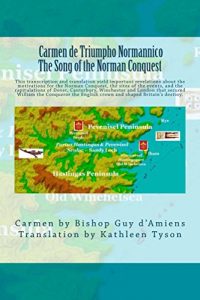Republished in July 2014 with an Introduction on competing claims to the English crown and 1066 geography, this is an all new transcription and translation of the 1067 Latin Carmen by Bishop Guy d'Amiens - the earliest account of the Norman Conquest.
The Carmen provides a gripping account of ambition, war, plunder and conquest written just after the events of 1066. This new translation helps explain why, how and where the events of the Norman Conquest occurred.
The Introduction suggests the Normans landed in the Brede Valley, then a huge estuarine port named Portus Hastingas & Pevenisel. The port and its manors either side were possessions of Fecamp Abbey in Normandy until seized violently by Godwin and Harold during their rebellion against King Edward the Confessor in 1052. The Normans camped on the Hastingas strand awaiting King Harold's approach and raided the region for supplies, cattle and slaves. The battle of Hastings likely occurred on a ridge facing the valley known to the Saxons as Senlac - sandy loch.
The Carmen is an epic poem in Medieval Latin attributed to Bishop Guy d'Amiens and likely composed in 1067. Its 835 lines contain a wealth of detail about William of Normandy's claim to the English throne, the Normans' navigation, landing and fortifications, the Battle of Hastings, King Harold's death and burial, and the political accommodation King William agreed with the citizens of London to secure their assent for his consecration as king.
The Carmen follows the conquest from Normandy to St Valery-sur-Somme to the Sussex coast to the blood-stained ridge where the battle was fought, to King Harold's burial, to Hastings, Dover, Winchester, Westminster and London. Throughout it offers a deeper understanding of the motivations, personalities and politics that influenced great events.
The Song of the Norman Conquest is a must read for students and historians of the Norman Conquest and a fun read for everyone else.
The Carmen provides a gripping account of ambition, war, plunder and conquest written just after the events of 1066. This new translation helps explain why, how and where the events of the Norman Conquest occurred.
The Introduction suggests the Normans landed in the Brede Valley, then a huge estuarine port named Portus Hastingas & Pevenisel. The port and its manors either side were possessions of Fecamp Abbey in Normandy until seized violently by Godwin and Harold during their rebellion against King Edward the Confessor in 1052. The Normans camped on the Hastingas strand awaiting King Harold's approach and raided the region for supplies, cattle and slaves. The battle of Hastings likely occurred on a ridge facing the valley known to the Saxons as Senlac - sandy loch.
The Carmen is an epic poem in Medieval Latin attributed to Bishop Guy d'Amiens and likely composed in 1067. Its 835 lines contain a wealth of detail about William of Normandy's claim to the English throne, the Normans' navigation, landing and fortifications, the Battle of Hastings, King Harold's death and burial, and the political accommodation King William agreed with the citizens of London to secure their assent for his consecration as king.
The Carmen follows the conquest from Normandy to St Valery-sur-Somme to the Sussex coast to the blood-stained ridge where the battle was fought, to King Harold's burial, to Hastings, Dover, Winchester, Westminster and London. Throughout it offers a deeper understanding of the motivations, personalities and politics that influenced great events.
The Song of the Norman Conquest is a must read for students and historians of the Norman Conquest and a fun read for everyone else.






